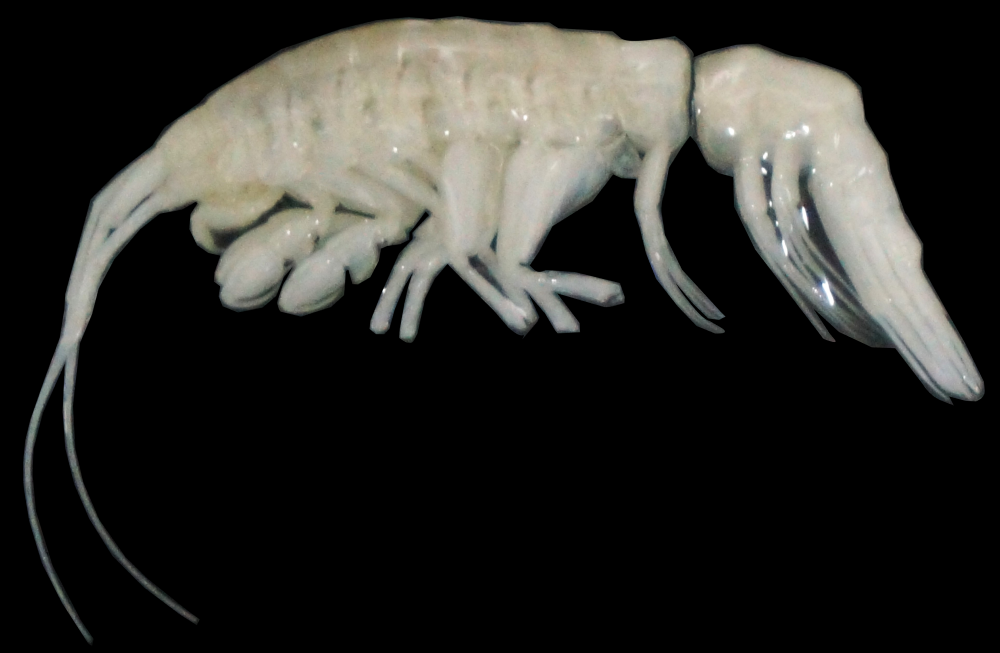A new-to-science predator has been identified from the hadal depths of the Atacama Trench, a first for this island-like ecosystem in the Southeast Pacific. Here, scientists had loaded bait traps with some chicken in an effort to lure in some scavengers and instead found themselves with a whopping great predatory amphipod– something that had been documented in other hadal subduction trenches, but never the Atacama.
The new species was caught at a depth of 7,902 meters (4.9 miles) during a 2023 expedition and has been named Dulcibella camanchaca, after the term for “darkness” in the languages of the peoples from the Andes region. Fitting for a critter that hunts in the darkest depths of one of the deepest trenches on the planet.
In their paper, the scientists behind its discovery describe its capture as “unexpected”, but that’s just the way it goes with fishing.
We now have one more piece to the puzzle of the Atacama Trench ecosystem
Johanna Weston
“With baited traps, it is essential to remember that we are fishing,” lead author Johanna Weston of the Woods Hole Oceanographic Institution told IFLScience, “And with fishing, there is a lot of skill, but also a lot of luck. The use of chicken versus a smelly fish, like mackerel, might have attracted the food of Dulcibella camanchaca, which we didn’t specifically investigate through an analysis like gut content analysis. Or it might be nothing to do with the type of bait, and it is all to do with depth, location, and/or timing.”
This area of the trench also hadn’t been sampled before, so it’s possible the area sampled is a particular hit for Dulcibella, as they were able to capture several individuals. However, the exact reason behind its surprising debut remains a mystery.
The newly discovered crustacean Dulcibella camanchaca is the first large, active predatory amphipod from the extreme depths of Atacama Trench.
Image credit: Johanna Weston, ©Woods Hole Oceanographic Institution
“That is the exciting part of deep-ocean ecology,” Weston continued. “There is always something new to learn and discover, and we now have one more piece to the puzzle of the Atacama Trench ecosystem.”
And what a puzzle piece it is, having evolved to capture living, moving animals at the depths that experience immense pressure and limited visibility. Fortunately, as co-author Carolina E González of the Instituto Milenio de Oceanografía told IFLScience, it “is perfectly adapted to such an extreme environment.”
Even though it lacks eyes, it can probably rely on other senses to detect food in the pitch darkness of the ocean floor
Carolina González
“It has a slender and agile body that likely allows it to move easily along the seafloor. Its front legs are large and strong, resembling pincers, which are probably ideal for catching and holding prey. Additionally, it has robust teeth in its jaws for cutting and crushing food, as well as legs likely adapted for moving across different types of substrates.”
“This amphipod is quite large for its type (almost 4 cm [1.6 inches] long), which likely helps it hunt smaller prey. Even though it lacks eyes, it can probably rely on other senses to detect food in the pitch darkness of the ocean floor.”
The discovery of such a large and previously undocumented predator in the Atacama Trench marks an exciting step forward in our understanding of this strange ecosystem, where species must compete with the extremes of depth, pressure, and darkness. However, for the multifaceted amphipods, it’s perhaps unsurprising that we have yet another example of the myriad of ways they have adapted to the Earth’s aquatic and marine environments.
Dulcibella camanchaca uses specialized raptorial appendages to capture and prey upon smaller amphipod species in the Atacama Trench’s food-limited realm. The trench stretches along the eastern South Pacific Ocean, plunging to depths exceeding 8,000 meters.
Image credit: Johanna Weston, ©Woods Hole Oceanographic Institution
“What is remarkable about amphipods is that they are so diverse and can be found in many places, like headwater streams, caves, the beach, and the deepest parts of the ocean,” said Weston. “Surprisingly, until fishes, the species that live at depth don’t look wildly different from those at the beach.”
“There are differences, but overall, the body plan has many similarities. There are likely to be some differences at the microbial and molecular levels. While we didn’t investigate for this study, future work could examine if they have a novel gut microbiome and the types of piezophilic proteins that help Dulcibella camanchaca‘s cells maintain function at depth.”
A new observation station has been established by the Instituto Milenio de Oceanografia (IMO) where Dulcibella lives, and it’s hoped that there could be more new species on the way following a subsequent expedition to the region in October. The Woods Hole Oceanographic Institution is also making exciting advances on the sea floor as part of a project Weston is involved In called DeepZoo – a new biodiversity sampler set to visit hydrothermal vents at the East Pacific Rise in January on an R/V Atlantis research expedition.
It looks like 2025 could be a very good year for deep-sea beasties research.
The study is published in the journal Systematics And Biodiversity.
Source Link: First-Of-Its-Kind Predator Caught 8,000 Meters Deep In The Atacama Trench
